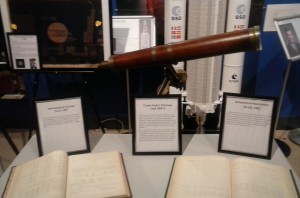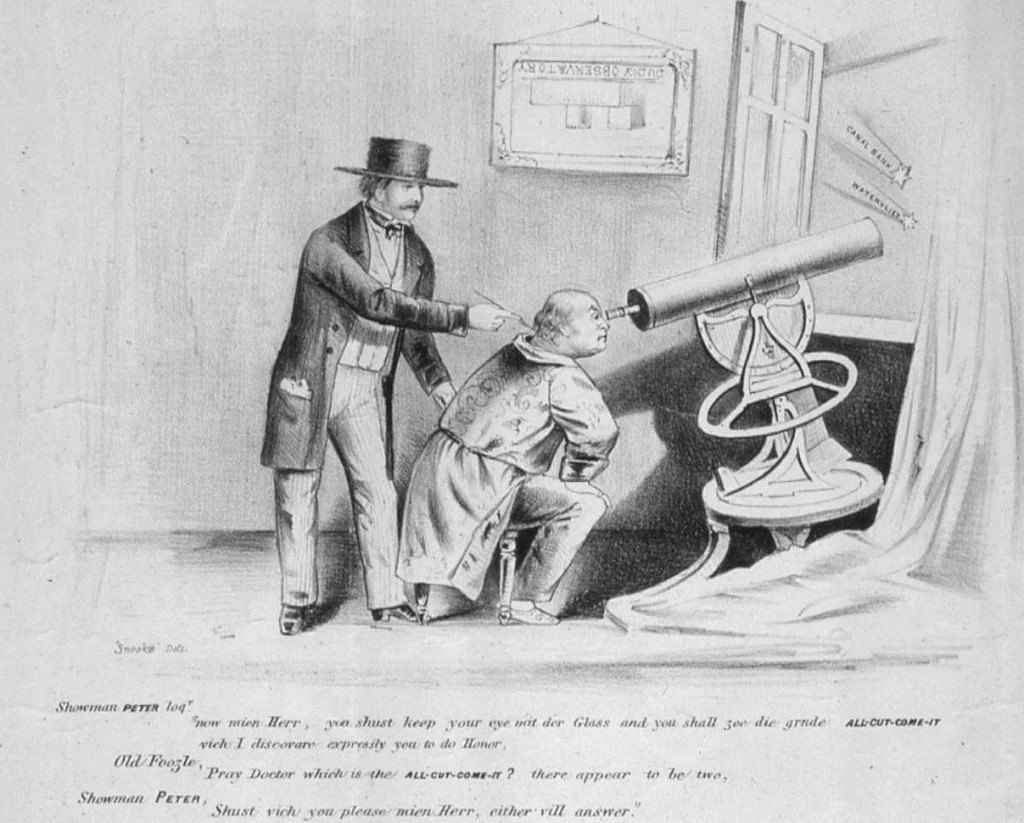The All-Cut Come-It

Dr. Rapson put together this display in our Planetarium Gallery. That’s the Dudley’s Comet Seeker telescope, built by Alvan Clark & Co., along with articles from the Astronomical Journal detailing the two comets that the telescope discovered. The first was discovered by Dr. Christian Heinrich Friedrich Peters, known as C.H.F. Peters for obvious reasons.
In the summer of 1857, Dr. Peters was in charge of the observatory. The actual director, Benjamin Gould, was away in Cambridge, and Peters was stuck with the unenviable task of running an observatory that was still in the slow, halting stages of being constructed. Peters was well aware that that the Dudley’s trustees were unhappy with the slow progress of the construction. The Detroit Observatory in Ann Arbor had been commissioned in 1854, around the same time as the Dudley Observatory, but was almost complete. Meanwhile, the Dudley Observatory had been inaugurated in August, 1856, but the building was not functional at that point, and a year later it still hadn’t set up its primary telescope.
All Peters had to work with was the Comet Seeker, so he sought comets. On July 25, 1857, he found one. In the Astronomical Journal, he announced:
The Comet was found (as astronomers have been notified by Circular) on the evening of July 25, at the Dudley Observatory. If the priority of discovery remains to me, I propose to call it the Olcott Comet, after the very beloved and esteemed name of the distinguished citizen who is identified with the history of the erection of this observatory.
If that last part was a bit obsequious, it was also very shrewd. Thomas Olcott was the President of the Mechanics and Farmers Bank of Albany, one of the wealthiest banks of the era. Tremendous amounts of raw goods and farm products flowed through Albany, much of it purchased through loans provided by Olcott’s bank. Thomas Olcott was also one of the primary movers on the board of Dudley. Finding a comet and making a big production out of it could go a long way towards proving that the proto-observatory was functional, and placating the trustees.
Unfortunately, it didn’t work out that way. Benjamin Gould was on record as opposed to naming comets and asteroids. The sober Gould thought they should be given an index number and nothing else. So the “Olcott Comet,” the fourth comet discovered in 1857, should have been Comet 1857-IV. Having a person who was technically his subordinate go against his wishes made Gould look bad, and his relationship to Peters soured. When Gould suggested that the name be dropped, his relationship to Olcott and the rest of the board suffered.
Apparently Gould wasn’t the only one unimpressed by Peter’s gesture. Consider this political cartoon:

Showman PETER, “now mein Herr, you shust keep your eye mit der Glass and you shall zee die grnde ALL-CUT-Come-it vich I discovare expressly you to do Honor.
Old Foozle, Pray Doctor, wich is the All-Cut-Come-It? There appear to be two ,
Showman PETER: Shust vich you please mien Herr, either vill answer.”
This cartoon by an unknown artist writing as “Snooks” shows “Showman Peter” (presumably C.H.F. Peters) talking to “Old Foozle” (presumably Thomas Olcott) in an absurd accent (Peters was an immigrant, born in Denmark). Foozle sees two comets, one labeled “Canal Bank,” the other “Watervliet.”
Unfortunately, the exact scandal that this comments on is now lost to history. This was during the Panic of 1857, and Olcott’s bank was suffering like all the rest. Perhaps he had to choose a bank to liquidate? Regardless, it seems that the artist was less than impressed with Peters. Just above Foozle is a picture labeled ‘Dudley Observatory’ hanging upside down.
